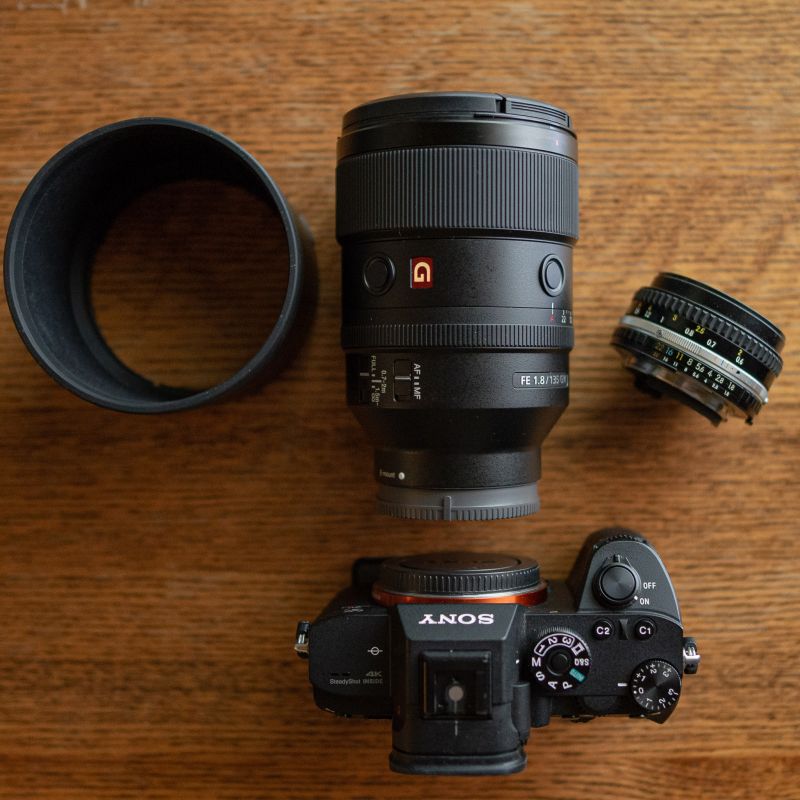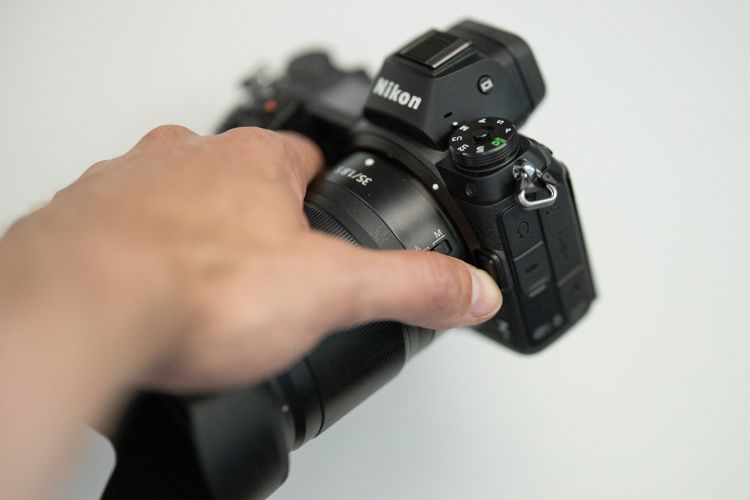
Okay, if you’re a photographer who loves to argue, but has been hiding under a rock for the last year or so, you might find this article very interesting.
On the other hand, if you’re just a photographer who loves to take pictures with amazing cameras and lenses, please close this window and go take pictures! Here’s a picture I took this morning for my review of the Sony A7R IV:

Alright, now that we’ve got that disclaimer out of the way, let’s lay down all the facts, and see if we can’t shake out the fiction, of this rather bizarre argument…
This is part 2 of our continuing “Canon VS Nikon VS Sony” discussion. For part 1, CLICK HERE. The goal of these articles is not to start a flame war or crown one brand a winner, but to simply present all the facts and help you decide how they’ll affect your real-world photography pursuits.
Many photographers, even “experts” on the internet who do gear reviews, have only ever held one, maybe two, camera systems in their whole life. At SLR Lounge, we’ve spent over a decade thoroughly mastering each camera system, shooting everything from portraits and weddings to wildlife and action sports, from landscapes to nightscapes, so that we can help other photographers make the best decisions about gear.
So, How Does Sony’s E-Mount Actually Measure Up?

If you have your measuring tape at the ready, we’ll begin with the actual, quantitative information, before we let any subjective opinions start stinking up this discussion:
| MOUNT | DIAMETER | FLANGE DISTANCE | SENSOR SIZE |
| Sony E-Mount | 46.1mm | 18mm | Full-Frame |
| Canon RF Mount | 54mm | 20mm | Full-Frame |
| Nikon Z Mount | 55mm | 16mm | Full-Frame |
| Leica L | 51.6mm | 20mm | Full-Frame |
| Canon EF-M | 46.5mm | 18mm | APS-C |
| Fuji X | 44mm | 17.7mm | APS-C |
| Micro Four Thirds | 44mm | 20mm | 2X Crop |
| Canon EF (DSLR) | 54mm | 44mm | Full-Frame |
| Nikon F (DSLR) | 44mm | 46.5mm | Full-Frame |
Okay next, here’s some color coding, just for fun. Hopefully, you can stomach the slight subjectivity of me coloring Nikon the “winner” here:

Let’s break down what we’re looking at- first and foremost, check out those DSLR mounts at the bottom. Both had a more-than-double flange distance compared to mirrorless; in fact, that’s the biggest difference between any measurement, by a long shot.
Also, Nikon’s DSLR mount diameter was/is a whole 10mm narrower than Canon’s; this was the subject of endless debate regarding how Canon could get such fast apertures and such good bokeh.
The question was, “could Nikon even make an F-mount 50mm f/1.2 or 85mm f/1.2, that had autofocus communication?” Thankfully, I think we can finally conclude- it doesn’t matter; the Z-mount is here.

Nikon has their “revenge”, with the utterly massive Z-mount. One has to wonder if they chose 55mm specifically because they wanted to be the new champion. (They must have suspected that Canon felt 54mm was already perfect?)
Indeed, the second observation is that Nikon’s full-frame Z-mount has both the widest lens mount diameter and the shallowest flange distance. This means, in case you’re wondering, that you can theoretically mount any other lens from any other mount on a Nikon Z-series camera, with the right adapter. (A Sony FE to Nikon Z adapter is already out, and apparently works pretty decently, even with autofocus!)
As a side note, it also means that a “Z” sensor is the most likely to get scratched by careless photographers. If you buy a Nikon Z6 or Z7, do yourself a huge favor and change lenses very carefully!

Lastly, we must now admit that Sony’s E mount has a diameter that is indeed much closer to the diameters of APS-C and even Micro-Four-Thirds mirrorless systems. In fact, Canon’s own EF-M (APS-C) mirrorless mount is a fraction of a millimeter larger than Sony’s full-frame mount, and the 2X cropped Micro Four-Thirds mount is barely two millimeters smaller than Sony’s full-frame E-mount.
Why is Sony’s E-mount this small? Because that’s exactly what it is; the E-mount was first an APS-C camera system about three years before it was a full-frame one. (Indeed, that’s why it’s not called the FE-mount; FE lenses go on the E-mount.) Whether they originally planned to take that mount full-frame or not, we’ll never know. The mount is indeed wider than Nikon’s old full-frame F-mount, so who knows, maybe Sony was planning to do full-frame E-mount cameras all along, and just opt for a more portable, compact mount…

Like it or not, but everything that has been stated until now has been mostly verifiable facts. So, what do these facts actually mean, to real photographers? As we’ll discuss next, they don’t mean much at all, to most photographers.
Are Current Sony FE Lenses “Held Back” By The E-Mount Size?

Instead of forming any conclusions right away, let’s see if we can account for just a few more hard facts first. Then, just maybe, our conclusions might actually be useful to any photographer who is considering a mirrorless camera system.
(Or, if you’re a die-hard camera geek who’s already made up your mind about this whole debate, and are just skimming through it so that you can drop a popcorn-eating-MJ meme in the comments, maybe you’ll at least leave this page armed with a better understanding of the actual situation so that you can advise your friends when they ask you what camera system they should buy into.)
1.) Pretty much all of the latest Sony FE lenses are incredible

Let’s state something that is admittedly a little subjective, but still rather hard to argue against: on the Sony E-mount, both name brand and third-party lenses have been truly impressive lately. From the exotic “GM” lenses such as the Sony FE 24mm f/1.4 GM and Sony 135mm f/1.8 GM, to the more modest “G” lenses such as the Sony FE 35mm f/1.8 G, one thing is clear: FE lenses can be incredibly sharp, and they can render beautiful colors, tones, and bokeh.
This means that if you’re a photographer who is looking for great f/1.8 and f/1.4 primes or great f/2.8 and f/4 zooms, then don’t worry, Sony’s E-mount will never let you down.
In fact, that smaller mount diameter will consistently help you save quite a few ounces/grams in your overall kit, since it’s effectively an APS-C mount form factor with a full-frame sensor crammed inside. That’s not to say that all of the full-frame mounts aren’t delightfully portable, though. The Canon EOS RP especially proves this.
So, moving on- what about pushing the boundaries of optics, and accomplishing things that simply never happened before?
2.) Quite a few Sony FE lenses achieve things that never happened on a DSLR.
Sony has quite a few lenses that are smaller, lighter, and/or sharper than we’ve ever seen from equivalent aperture & focal length DSLR lenses.
Look at the 135mm f/1.8 category: A Sigma 135mm f/1.8 Art does achieve incredible sharpness, however, the Sony FE 135mm f/1.8 GM is a bit smaller, lighter, and yet somehow also manages to cram in a much better AF motor, too.

There are numerous other lenses that come to mind when comparing both weight savings and sharpness to any DSLR competition. The Sony Fe 24mm f/1.4 GM is much smaller and lighter than DSLR options, yet its sharp corners destroy the competition.
In the affordable third-party realm, too, there are awesome lenses like the Tamron 17-28mm f/2.8, which are ultra-portable, and yet still incredibly sharp right to the very corners. There are also lenses which do compromise on edge sharpness just a little bit, such as the Rokinon/Samyang 24mm f/2.8 and 35mm f/2.8, which are downright “pancake lens size in their portability.
Note, however, that I did not say such lenses were impossible on a DSLR. I simply said, they never happened. Could such lenses have happened on a DSLR? Maybe, but if their goal was portability then they’d probably compromise on sharpness, or if their goal was sharpness then they’d probably compromise on portability. On average, Sony FE is offering more than you could have gotten on any DSLR.
3.) Sony’s FE Lineup Is Pretty Much Complete

Here’s the first bottom line, folks: Sony’s FE lens lineup is extensive, indeed it’s virtually complete, with very little room for improvement or expansion.
Maybe we’ll soon get an update to the Sony 24-70mm f/2.8 GM or 16-35mm f/2.8 GM. Maybe we’ll see a 35mm or 50mm f/1.4 GM. Who knows!
More importantly, are any of these future “normal” lenses going to be held back by the diameter of that E-mount? NOPE.
So, let’s spell it out very clearly: Any optical limitations due to the mount diameter are non-existent, for all COMMON focal lengths and apertures.
(Yes, we’re leaving room here for, well, “uncommon” focal length and aperture combinations. Got your can openers ready? Here come the worms…)
Do Canon And Nikon Have Any Advantage With Their Newer, Bigger Full-Frame Mirrorless Mounts?
Finally! Can, open. Worms, everywhere: Canon and Nikon’s full-frame mirrorless mounts, being much wider in diameter, might be capable of more exotic “unicorn” lenses than Sony.
To be fair, once again the real facts should come first: Canon has already got two (well, three) f/1.2 full-frame primes out for their RF mount, and one f/2 zoom. All of them are incredibly sharp, even in the extreme corners, and produce generally gorgeous images.

Nikon, on the other hand, has their most exotic unicorn, of course, the 58mm f/0.95 Noct. Also, the Nikkor Z 14-30mm f/4 S is impressive for the exact opposite reason- it’s downright tiny, and yet it reaches 14mm on the wide end, accepts 82mm threaded filters, and still offers pretty impressive sharpness even in the extreme corners. It may be a modest f/4 zoom, but it’s totally unprecedented in its form factor, and drool-worthy for all lightweight travel landscape photographers. Then there’s Nikon’s flagship-grade f/1.8 primes, which are on par with many f/1.4 and f/1.2 primes of the “old” DSLR days. (To be fair, f/1.8 primes are one thing Sony can do amazingly well, too!)
Anyways, within one year of their full-frame mirrorless debut, Canon and Nikon have presented at least five (or ten, if you’re generous) lenses that not only achieve portability/sharpness combinations that were virtually impossible in the DSLR realm, but also, (here it comes) …at least five optics that Sony simply hasn’t done yet in the now six years of its FE history.
But, Could Sony Still Make These Exotic Lenses Too? YES.
Before we dive into our final speculations about what will actually happen in the future on each of these three full-frame mirrorless mounts, (or before everyone starts throwing rotten fruit) let’s settle the issue of “theoretical limits”. Because, simply put, the numbers are both informative and jaw-dropping.
After Leica “poked the bear” in late 2018 by claiming that Sony’s E-mount wasn’t even designed for full-frame originally, (which does seem true, based on the numbers alone) …Sony responded in early 2019 with some quantifying info about the theoretical limits of what apertures would be possible on their E-mount, compared to Canon’s RF and Nikon’s Z. The surprise? All three numbers are insane: Sony ‘s mount could theoretically accept an f/0.63 lens, while Canon’s RF could do f/0.62 and Nikon’s Z could do f/0.58.

All of these theoretical limits are WAY beyond any lens that will ever actually exist. We’ve already seen just how large the Nikkor 58mm f/0.95 “Noct” is, and I don’t think we’ll ever see a faster lens that can match the sharpness of the Nikon.
So, here’s the bottom line: yes, Sony can probably do any lens that Canon or Nikon can do, even the ultra-exotic ones. We’ve already seen the Sigma 35mm f/1.2, and it’s one of the sharpest 35mm’s ever made…
The only remaining likelihood, then, would be that maybe, just maybe, the extreme corners of such extremely exotic lenses would show poorer image quality in FE form, than they might as a Nikkor Z
And that, right there, is really as close as we can get to a factual conclusion, based on the measurements at hand and a basic understanding of optical formulas. A disappointingly vague, “…but the corners probably wouldn’t be as good.”
So, How Exotic will Sony FE Lenses Really Get?

With that groundwork laid, we can finally tackle the real question that the whole discussion actually hinges on, even though unfortunately everyone engaged in this argument fails to consider:
Will we ever actually see a Sony FE 50mm f/1.2 GM? Maybe, if we’re lucky, but what about an 85mm f/1.2 GM? Probably not. Likewise, could we see an f/2 GM zoom or two? Maybe, but I’m not holding my breath.
Or, in the opposite direction, what about an f/4 FE zoom that goes as wide as 14mm and yet is still ultra-portable, sharp in the corners, and accepts 82mm filters? Maybe, maybe not.
Either way, one thing is clear: it does seem that Canon and Nikon are trying to make their full-frame mirrorless mounts very attractive right off the bat. If I were a portrait and wedding photographer, I would seriously consider Canon’s RF lenses to be some of the most exciting options. As a landscape, nightscape and wilderness adventure photographer, Nikon’s combination of portable f/1.8 primes and f/4 zooms are a dream kit. Plus Nikon’s also got one or two f/1.2 autofocus primes on their roadmap, and their Z 24-70mm f/2.8 S is definitely the new gold standard of 24-70mm’s.

It all comes down to this: regardless of whichever lenses are optically possible, or even probable, that’s not even the final piece of the puzzle. The final piece is, of course, …which lenses do you see yourself actually buying and using?
Whatever slight difference there might be in the theoretical limits, or whatever exotic optics actually come to fruition, most photographers are going to be more than happy with any system. Indeed, they’re much better off choosing a system based on criteria that includes literally anything else…

There are many photographers who already know they love f/1.2 primes, of course. I just said that if I were exclusively a portrait photographer, Canon’s RF mount would be the most tempting choice, even though I could surely get any job done with any of the very impressive portrait lenses for Nikon or Sony. And, although I don’t think I’ll ever own the Nikon 58mm Noct, I’ll still look forward to seeing if Nikon makes their own 35mm, 50mm, and 85mm f/1.2 AF optics.
Sony FE could also get some of those exotic lenses, whether from Sony or Sigma or someone else. They might not be able to achieve the same level of extreme corner sharpness, as a vague prediction, but they’ve proven everyone wrong with fast glass corner sharpness multiple times already.
At the end of the day, that’s all we can say with any certainty- Almost anything is theoretically possible on Sony’s E-mount. But, maybe, just maybe, it is slightly less probable that we’ll actually see as large of a collection of “inconceivable” optical accomplishments. If true, though, it wouldn’t even be primarily a limitation of the mount, ironically, it would be simply due to Canon and Nikon’s desire to stand out.
Conclusion | The answer is NO, Unless you know you’re “all about that glass”
Alright, folks. You make up your mind. Then, please, put this whole debate out of its misery. There are so many reasons to choose one camera system over another, and this is just one of them. For most photographers, it’s a non-issue.
Please leave a comment if you have any inclination one way or the other! Or, leave a comment if you’re just disappointed over this vague, un-helpful conclusion. The honest truth, though, is that from serious hobbyists to full-time professionals, this argument isn’t worth your time. Hopefully, now that you know all the facts, you can move on to more important things in your creative journey.
Matthew Saville
Follow his wilderness nightscape adventures on Instagram: instagram.com/astrolandscapes





Get Connected!